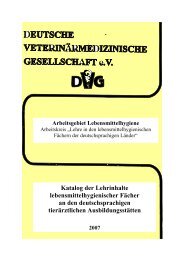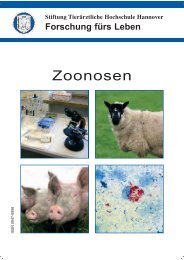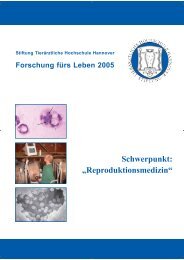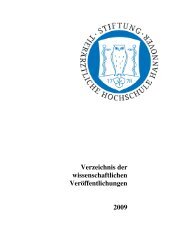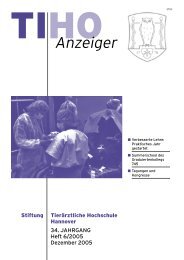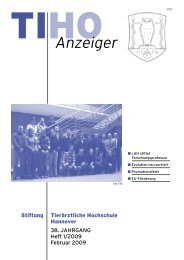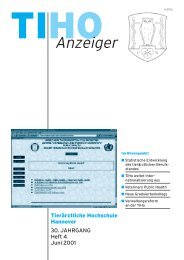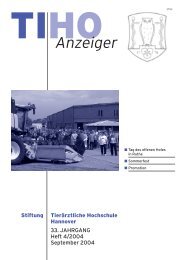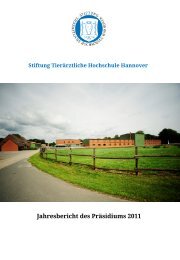The Situation in Denmark
The Situation in Denmark
The Situation in Denmark
You also want an ePaper? Increase the reach of your titles
YUMPU automatically turns print PDFs into web optimized ePapers that Google loves.
<strong>The</strong> <strong>Situation</strong> <strong>in</strong> <strong>Denmark</strong><br />
and the Danish Approach and Experiences<br />
Tim Petersen<br />
Special Vet. advisor, bus<strong>in</strong>ess developer and project manager<br />
DVM, GDBA<br />
Division for Animal Welfare and Veter<strong>in</strong>ary Medic<strong>in</strong>e
2<br />
Menu<br />
• <strong>Denmark</strong> <strong>in</strong> Numbers <strong>in</strong> Short<br />
• <strong>The</strong> Yellow Card Initiative<br />
• Results so far<br />
• Other Important Initiatives on<br />
Antimicrobials
3<br />
21+ million pigs<br />
slaughtered 2010.<br />
6+ mill. piglets<br />
exported 2010.<br />
Pig Population<br />
app. 12.5 mill.<br />
Human<br />
Population 5 mill.<br />
<strong>Denmark</strong> <strong>in</strong> Numbers
4<br />
Use of Antibiotics <strong>in</strong> Animal Production <strong>in</strong> <strong>Denmark</strong><br />
Tonnes (active component)<br />
250<br />
200<br />
150<br />
100<br />
50<br />
0<br />
1990<br />
1992<br />
1994<br />
1995<br />
1996<br />
1997<br />
1998<br />
1999<br />
2000<br />
2001<br />
2002<br />
2003<br />
<strong>The</strong>rapeutic AGPs<br />
2004<br />
2005<br />
2006<br />
2007<br />
2008<br />
2009<br />
2010
5<br />
100<br />
50<br />
0<br />
Contribution of Pig Consumption<br />
24 24 23<br />
Veter<strong>in</strong>ary use<br />
of antibiotics <strong>in</strong> tons<br />
2001 - 2010<br />
Pigs Other species<br />
22 22 26 25 25<br />
72 72 79 90 90 88 94 93 104 100<br />
2001 2002 2003 2004 2005 2006 2007 2008 2009 2010<br />
26<br />
18
6<br />
<strong>The</strong> Yellow Card Initiative
7<br />
Monitor<strong>in</strong>g of use of Veter<strong>in</strong>ary Medic<strong>in</strong>es<br />
VetStat<br />
Veter<strong>in</strong>ary Prescription Medic<strong>in</strong>e Data Input<br />
S<strong>in</strong>ce 2001<br />
Vet<br />
Pharmacy<br />
10% 85% 5%<br />
VETSTAT<br />
Feed<br />
plant
8<br />
Monitor<strong>in</strong>g of use of Veter<strong>in</strong>ary Medic<strong>in</strong>es<br />
VetStat PIGS<br />
Veter<strong>in</strong>ary Prescription Medic<strong>in</strong>e Data Input<br />
Vet<br />
Pharmacy<br />
< 1% > 97 % 2 %<br />
VETSTAT<br />
Feed<br />
plant
9<br />
Farmer<br />
Slaughter houses<br />
Markets<br />
Export facilities<br />
Central Husbandry Register<br />
Animal data <strong>in</strong>put<br />
CHR
10<br />
• Data:<br />
<strong>The</strong> Concept <strong>in</strong> short<br />
• Amount of antibiotics used on farm <strong>in</strong> a specific age<br />
group <strong>in</strong> ADD (from VetStat)<br />
• Number of pigs days for that specific animal group<br />
(from CHR)<br />
• <strong>The</strong> Yellow Card Level<br />
• Based on 9 months average<br />
• Amount antibiotics used / Number of pig days
11<br />
9 months roll<strong>in</strong>g avg.<br />
(ADD/100 animals per day)<br />
National mean<br />
Yellow Card Threshold<br />
<strong>The</strong> Threshold Levels<br />
F<strong>in</strong>ishers<br />
(30 – 120 kg)<br />
4<br />
8<br />
Weaners<br />
(7 – 30 kg)<br />
14<br />
28<br />
Target<strong>in</strong>g 5 – 10 % of all pig farms<br />
Sows<br />
(>120 kg)<br />
2,6<br />
5,2
12<br />
<strong>The</strong> Yellow Card – In Short!<br />
Yellow Card Increased Supervision Red Card<br />
Second<br />
Op<strong>in</strong>ion<br />
9 mth. 5 mth. Until below the threshold<br />
www.dvfa.dk > Animal Health > <strong>The</strong> Yellow Card Initiative on Antibiotics
13<br />
Risk Communication<br />
Tools to Assist the Farmer/Vet
14<br />
Tools to Assist the Farmer/Vet �
15<br />
Tools to Assist the Farmer/Vet �
16<br />
K g a c tiv e d ru g p e r 1 0 0 0 s w <strong>in</strong> e<br />
2,40<br />
2,20<br />
2,00<br />
1,80<br />
1,60<br />
1,40<br />
1,20<br />
1,00<br />
1<br />
05<br />
2<br />
05<br />
3<br />
05<br />
4<br />
05<br />
1<br />
06<br />
2<br />
06<br />
3<br />
06<br />
4<br />
06<br />
Antibiotics 2005 - 2011<br />
per 1000 sw<strong>in</strong>e<br />
Yellow card reduction 30 % s<strong>in</strong>ce 1.Jan 2010<br />
Same level 3rd quarter 2011 as 5 years ago<br />
1<br />
07<br />
2<br />
07<br />
3<br />
07<br />
4<br />
07<br />
1<br />
08<br />
2<br />
08<br />
3<br />
08<br />
4<br />
08<br />
1<br />
09<br />
2<br />
09<br />
3<br />
09<br />
4<br />
09<br />
1<br />
10<br />
2<br />
10<br />
3<br />
10<br />
4<br />
10<br />
1<br />
11<br />
30%<br />
2<br />
11<br />
3<br />
11
17<br />
14500<br />
14000<br />
13500<br />
13000<br />
12500<br />
12000<br />
11500<br />
11000<br />
10500<br />
Pig Population <strong>in</strong> <strong>Denmark</strong><br />
Pigs <strong>in</strong> <strong>Denmark</strong><br />
(X1000)<br />
10000<br />
1998 1999 2000 2001 2002 2003 2004 2005 2006 2007 2008 2009 2010<br />
Data from Statistics <strong>Denmark</strong>
18<br />
What Should the Farmer Do To Meet the<br />
Expectations?<br />
• Non-antimicrobial Preventive measures<br />
– Ensure adequate facilities for the production of<br />
pigs<br />
– Improve on vacc<strong>in</strong>ation strategies<br />
– Improve on management, feed<strong>in</strong>g and water<strong>in</strong>g<br />
– Improve on breed<strong>in</strong>g and aquisition of pigs<br />
– Improve production hygiene
19<br />
25<br />
20<br />
15<br />
10<br />
5<br />
0<br />
Effect of Strategies<br />
Prevention of Disease - Vacc<strong>in</strong>ation<br />
Vacc<strong>in</strong>ations per 1000 sw<strong>in</strong>e<br />
Antal_vac._pr.1000 sv<strong>in</strong>
20<br />
Kg aktivt stof pr 1000 sv<strong>in</strong><br />
Effect of Strategies – Adm<strong>in</strong>istration Routes<br />
1,2<br />
1<br />
0,8<br />
0,6<br />
0,4<br />
0,2<br />
0<br />
1. kv 2008<br />
2. kv 2008<br />
3. kv 2008<br />
Injection- and oral treatment per 1000 sv<strong>in</strong><br />
2008 to 2011 3kv<br />
4. kv 2008<br />
1 kv 2009<br />
2 kv 2009<br />
3 kv 2009<br />
4 kv 2009<br />
1. kv 2010<br />
2. kv 2010<br />
3. kv 2010<br />
4. kv 2010<br />
1. kv 2011<br />
2. kv 2011<br />
3. kv 2011<br />
Injek_pr_1000_sv<strong>in</strong><br />
Vand_med_1000_sv<strong>in</strong><br />
Foder_med_1000_sv<strong>in</strong>
21<br />
Yellow Card Discussion<br />
Large decrease <strong>in</strong> usage could be attributable to:<br />
• INCREASED AWARENESS ON VET AND FARMER LEVEL<br />
• GOOD RISK COMMUNICATION VIA GRAPHS IN VETSTAT<br />
AND/OR<br />
• Poorly managed herds with low productivity and high usage of AM close bus<strong>in</strong>ess<br />
• AND/OR<br />
Stop of previous over-treatment<br />
Present under-treatment – DVFA will do <strong>in</strong>spections<br />
Effect of new (treatment) guidel<strong>in</strong>es<br />
Improved motivation for non-antimicrobial strategies<br />
– Increased use of vacc<strong>in</strong>ation strategies<br />
– Increased diagnosis quality and test<strong>in</strong>g frequency<br />
– Improved management reduc<strong>in</strong>g disease prevalence etc.
22 22<br />
Fluoroqu<strong>in</strong>olones 2002<br />
Strategic use – lab tests<br />
Action plan 2007<br />
Cephalospor<strong>in</strong> focus<br />
Supervision all vets<br />
2010<br />
Sw<strong>in</strong>e <strong>in</strong>dustry 1. July<br />
Cephalospor<strong>in</strong> ban<br />
Evidence based<br />
treatment guidel<strong>in</strong>es<br />
Effect of strategies on CIA<br />
Cephalospor<strong>in</strong>es (3rd og 4th gen.) and<br />
Fluoroqu<strong>in</strong>olones for production animals<br />
Kg aktivt stof<br />
140<br />
120<br />
100<br />
80<br />
60<br />
40<br />
20<br />
0<br />
Source: DTU<br />
2001 2002 2003 2004 2005 2006 2007 2008 2009 2010<br />
Sv<strong>in</strong>, Cephalospor<strong>in</strong>, syst.<br />
Kvæg, Cephalospor<strong>in</strong>, syst.<br />
Kvæg,Cephalospor<strong>in</strong>, <strong>in</strong>tram.<br />
Sv<strong>in</strong>, Fluork<strong>in</strong>olon, syst.
23<br />
So – What Does <strong>Denmark</strong> Do?<br />
• Monitor<strong>in</strong>g of use of veter<strong>in</strong>ary medic<strong>in</strong>e<br />
• Monitor<strong>in</strong>g of antimicrobial resistance<br />
• One-on-One relationship between farmer and vet<br />
• Focus on prevention through professional veter<strong>in</strong>ary advise<br />
• Restrict<strong>in</strong>g use of Critical Important Antibiotics<br />
• Restrict<strong>in</strong>g use of antibiotics <strong>in</strong> general<br />
• Focused risk communication on both CIA and AM <strong>in</strong> general
24<br />
Thank you for your attention!<br />
Questions?<br />
tipe@fvst.dk





